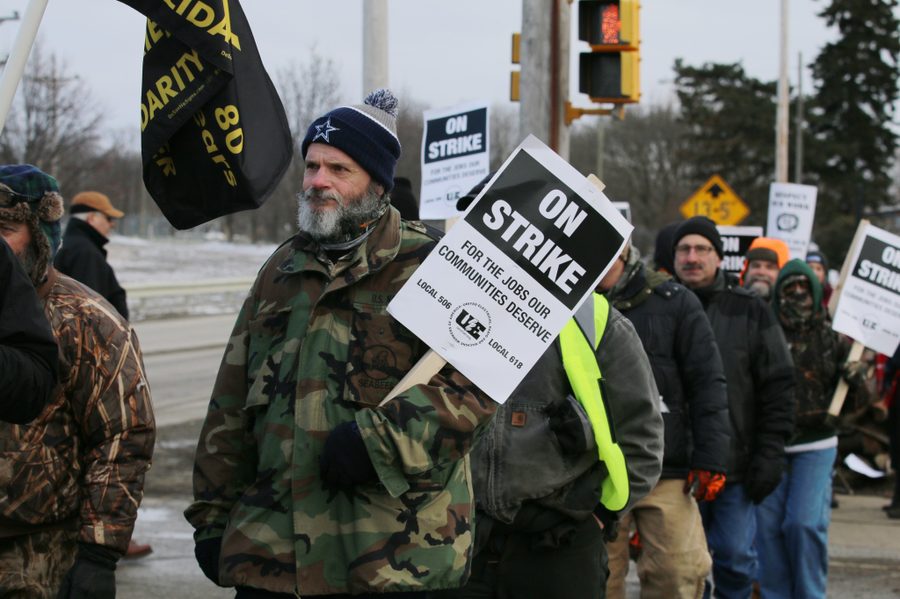The War Over No Strike Clauses Has a New Front Line
In Erie, PA, Wabtec workers are poised to fight for the right to strike.
Hamilton Nolan

“Man is born free and everywhere he is in chains,” philosopher Jean-Jacques Rousseau said in the 18th century. Likewise, the right to strike is the fundamental source of a union’s power, and everywhere they have signed that right away. “No strike clauses,” which ban workers from striking during the course of a union contract, have been ubiquitous for decades — the price, companies argue, of having a contract at all. Breaking out of this power-sucking bargain is a vital task for the labor movement, if it ever wants to be able to stand up to corporate America in a meaningful way.
The good news is that at least one union is actively trying.
In Erie, Pennsylvania, more than 1,000 workers who build locomotives at the Wabtec factory are members of UE Local 506. The plant was owned by GE for more than 80 years before Wabtec took it over in 2019. Under GE, the union had the right to strike over grievances: If grievances were not resolved after a three-step process of meeting with progressively more senior managers, workers could strike to force a resolution. UE says that they used that right sparingly — only four times in the 15 years before Wabtec took over, and for just hours on each occasion. The average management-side lawyer would have you believe that such a right would make the union greedy and enthusiastic to constantly throw sand in the company gears, but that was not the case. Instead, the union says, that right to strike maintained the balance of power between workers and management, and by doing so encouraged a good working relationship, and labor peace.
As soon as that right went away in UE’s first contract with Wabtec in 2019, things deteriorated. Speaking on a conference call Wednesday, Leo Grzegorzewski, Local 506’s chief steward at the plant, said that annual grievances have more than doubled under Wabtec. Even worse, the company appears to be blowing them off: Only 3 percent of grievances are settled in the first two meetings with the company, according to Grzegorzewski, and the company proceeds to reject 95 percent of the ones that reach the third and final step. After that, the only remaining tool now is to go to arbitration, which costs the union about $9,000 per case. And there are more than 30 cases in a typical month. The system is broken. Researchers at the Illinois School of Labor and Employment Relations published a study of the Wabtec plant just last week that confirmed everything that the union said: Under Wabtec, there are more grievances, they are less likely to reach closure, and the process drags on longer than ever before.
“Stall, stall, stall,” Grzegorzewski said, summing up the company’s approach. “Delay, delay, delay.”
Anyone with an iota of common sense can see what is happening here. GE knew workers could strike if it did not take the grievance process seriously, so it did. Wabtec knows the union has little recourse if it does not take the grievance process seriously, so it doesn’t. It’s a textbook example of how a no strike clause can make the day-to-day experience of workers on the job dramatically worse. As anyone who has been in a union knows, winning a contract is only half the battle. The other half is enforcing it. Just as companies understand that it’s in their interests to violate laws during organizing campaigns because the penalties for illegal union-busting are paltry, they also understand that they can feel free to interpret the contract in the most hostile way imaginable if all they have to fear is the remote possibility of an arbitration case months or years down the road. The workers at Wabtec are living proof that the deal that has been implicit in almost every union shop for decades — a contract in exchange for a no strike clause — is a losing proposition.
When my colleagues and I at Gawker Media got our first union contract, it did not have a no strike clause (purely because the lawyer we were negotiating with was a media lawyer, not a labor lawyer, and didn’t know any better). Our newly unionized company was sold to Univision, and soon, we got word that our new owners were planning drastic, across-the-board layoffs. Every division was getting slashed. But us? No. We agreed that we would all walk out unless Univision sat down and negotiated with us. Which they did. We managed to score far fewer layoffs than the rest of the company, and fatter severance packages. That only happened because we held onto our right to strike. When we were forced to accept a no strike clause in later contracts, owners proceeded to disrespect the union with a smirk. They had lost their fear.
The UE contract at Wabtec expires on June 9. The union will take a strike authorization vote this weekend, and they expect it to pass overwhelmingly. If they are forced to strike — in part to secure, once again, the right to strike over grievances — they will be doing a heroic service for the entire labor movement. As important as it is to erase the idea that contracts must preclude strikes, it is hard as hell to find unions willing to take the enormous risk of striking over the issue of the right to strike itself. Money, yes. Benefits, yes. But a right that can seem theoretical? It’s not easy to find the people who will put their own jobs on the line to blaze that trail. Because of that, the entire union world must be ready to throw its support behind the workers in Erie who may have a chance to prove that this can be done.
The stakes are enormous. If the grassroots energy in labor today was paired with the right to strike during contracts, the potential material gains could be huge. It could be enough to actually shift the creaky see-saw of power away from companies and towards their employees. Sara Nelson, the head of the Association of Flight Attendants and unofficial spokesperson for the left wing of the labor movement, was on the UE conference call, and pointed out that unions like hers that operate under the Railway Labor Act actually do have the right to secondary boycotts — meaning that one union throwing up a picket line at an airport could, in theory, lead to a cascading effect of unionized airline workers refusing to cross that picket line that would shut down air travel.
Expanding the right to strike makes workers stronger. Period. Always and everywhere. Today’s automatic inclusion of no strike clauses in contracts “should be something that is off the table for all of labor,” Nelson said.
That will take a while. But in Erie, workers may be poised to take a big step towards the promised land.
Hamilton Nolan is a labor writer for In These Times. He has spent the past decade writing about labor and politics for Gawker, Splinter, The Guardian, and elsewhere. More of his work is on Substack.








